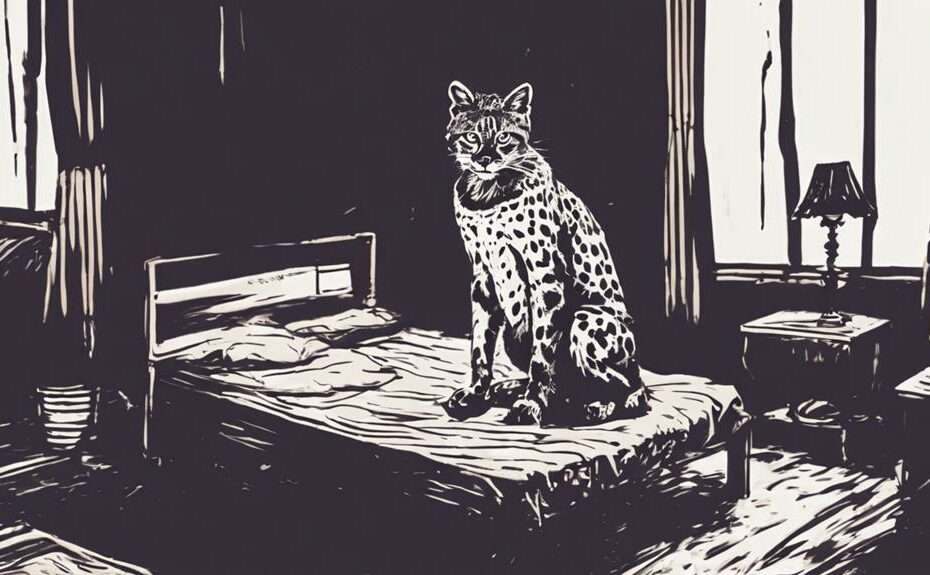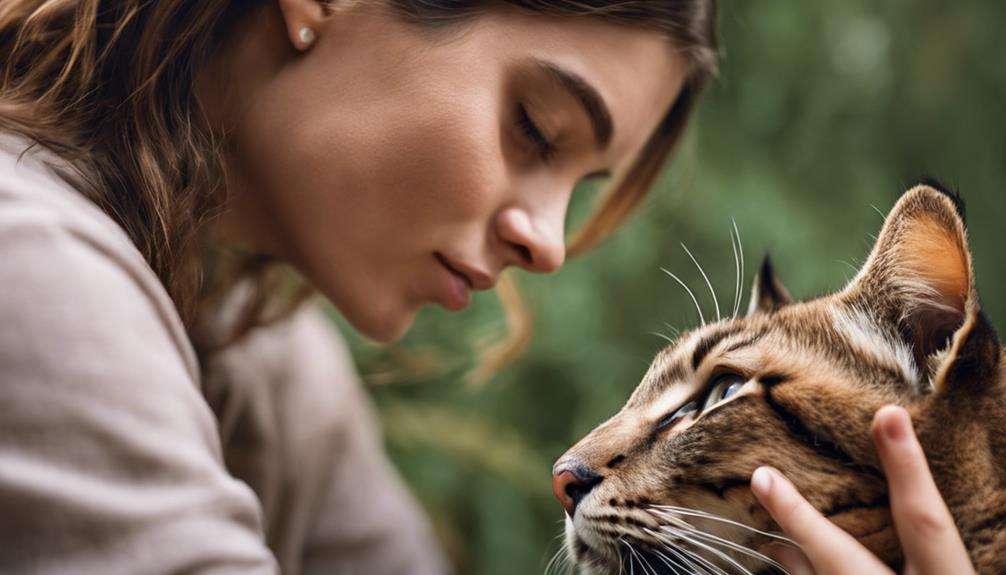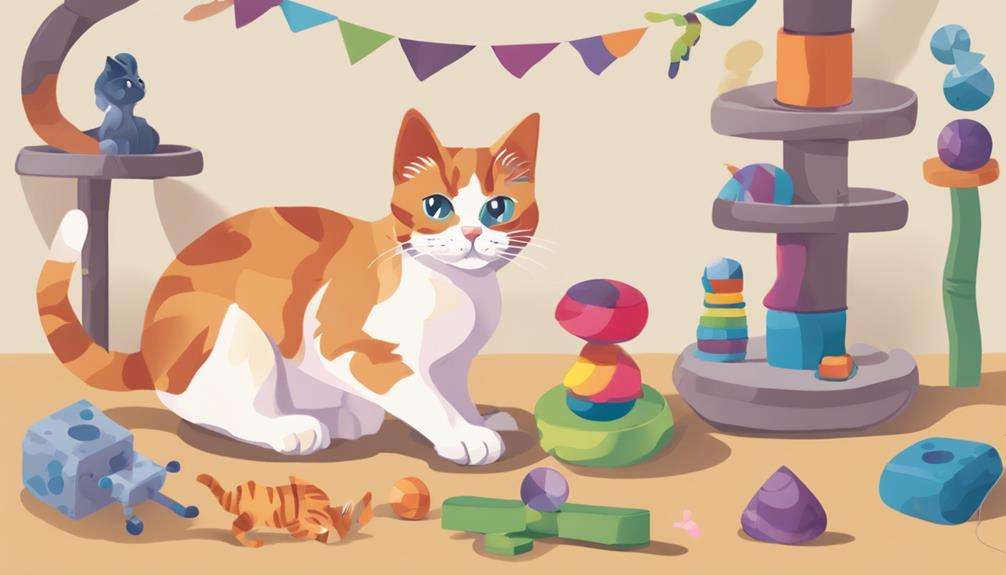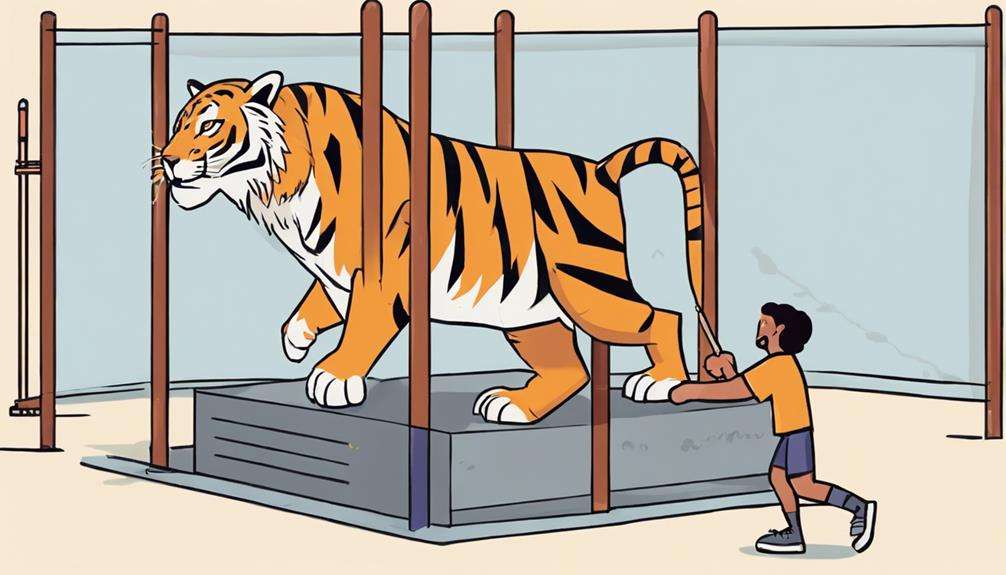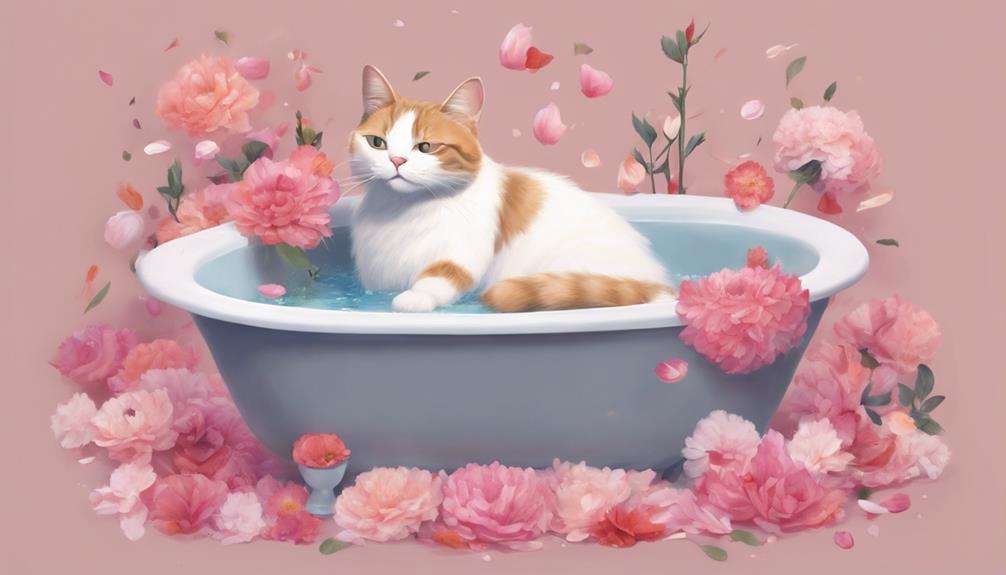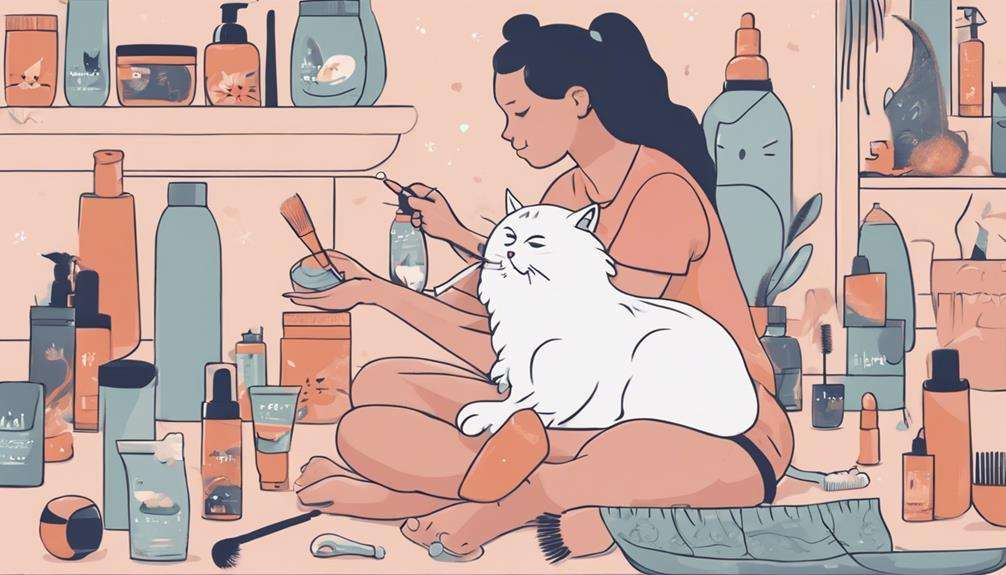Imagine the sleek, dappled coat of a spotted wildcat in your home, a symbol of untamed beauty. However, the allure of owning these magnificent creatures comes with a host of challenges that require careful consideration and preparation.
From legal hurdles to complex dietary needs and the demand for extensive space and enrichment, navigating the world of owning spotted wildcats is a multifaceted journey that demands your utmost attention.
Each aspect presents its own set of obstacles, shedding light on the intricate nature of caring for these elusive felines.
Key Takeaways
- Strict legal restrictions protect Rusty-Spotted Cats, prohibiting unauthorized ownership.
- Rusty-spotted cats require a meat-based diet and proper nutrition for health.
- Adequate enclosures with enrichment items are vital for their well-being.
- Stringent security measures and regular veterinary care are essential for their health and safety.
Legal Restrictions on Ownership
If you're considering owning a Rusty-Spotted Cat, it's crucial to understand the strict legal restrictions that protect these wild felines. These laws are in place to safeguard the species and ensure their conservation in the wild. Rusty-Spotted Cats fall under the category of wild animals, and ownership of such species is tightly regulated to prevent exploitation and endangerment.
Conservation efforts for the Rusty-Spotted Cat emphasize the significance of ethical practices and legal compliance. In countries like India and Sri Lanka, specific regulations prohibit individuals from owning these cats without the necessary permits. These restrictions aim to maintain the delicate balance of the species in their natural habitat and prevent unauthorized ownership that could harm their population.
Violating these legal restrictions not only carries severe legal consequences but also puts the well-being of these wild felines at risk. It's essential to respect and abide by these laws to contribute to the conservation and protection of the Rusty-Spotted Cat species.
Specialized Dietary Requirements
Ensuring proper nutrition for rusty-spotted cats in captivity is essential to their health and well-being, given their specialized dietary requirements. When caring for these exotic pets, it's crucial to pay close attention to their dietary needs to replicate their natural diet as closely as possible. Here are some key points to consider:
- Meat-Based Diet: Rusty-spotted cats require a diet that's primarily meat-based to meet their nutritional requirements adequately.
- Lean Meats: Their diet should consist of high-quality, lean meats such as chicken or turkey to ensure they receive the necessary nutrients.
- Challenges in a Domestic Setting: Replicating their natural hunting and feeding behaviors can be challenging in a domestic environment, necessitating careful planning and consideration.
- Consultation with a Veterinarian: To ensure that the rusty-spotted cat's specialized dietary requirements are met, consulting with an exotic animal veterinarian is highly recommended.
Need for Large and Secure Enclosures
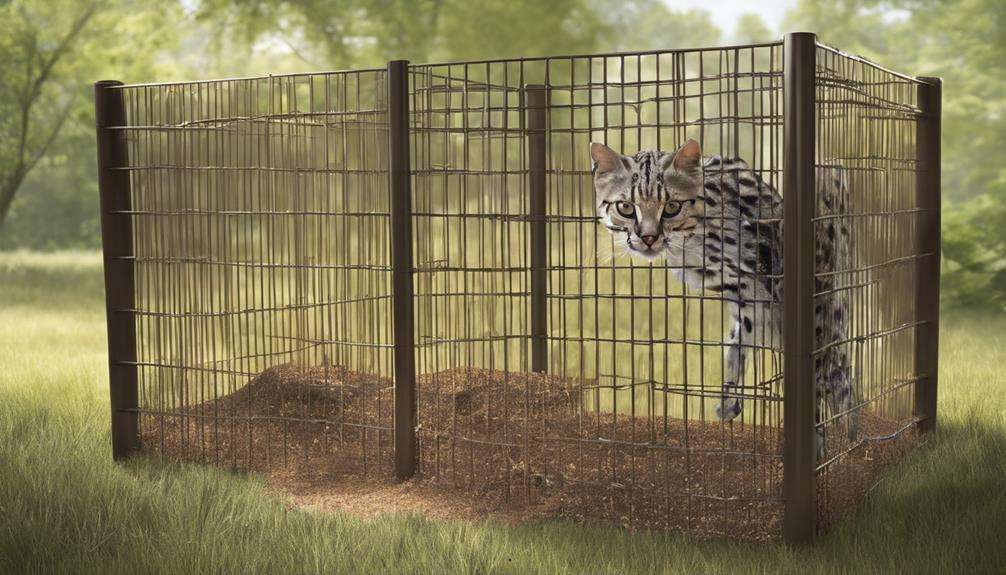
You must understand the crucial need for large and secure enclosures when it comes to owning spotted wildcats.
These majestic creatures require ample space to roam and exhibit their natural behaviors, while also needing protection from potential dangers.
Enclosure Size Requirements
The provision of spacious and secure enclosures is imperative when considering the needs of Rusty-Spotted Cats in captivity. Here's why:
- Habitat Size: Rusty-Spotted Cats require ample space to roam and exhibit natural behaviors.
- Territorial Behavior: Large enclosures help satisfy their territorial instincts and prevent stress.
- Enrichment Items: Including toys and hiding spots in the enclosure is crucial for their mental and physical well-being.
- Stress Prevention: Properly sized enclosures play a vital role in reducing stress and ensuring the overall welfare of these wildcats.
Ensuring the enclosure meets these requirements is essential for providing a suitable environment that promotes the health and happiness of Rusty-Spotted Cats in captivity.
Security Measures Needed
To provide a safe and enriching environment for Rusty-Spotted Cats in captivity, it's essential to implement stringent security measures in their enclosures. These spotted wildcats require large enclosures that offer climbing opportunities and ample space for exercise, mirroring their natural behaviors.
Due to their adept climbing skills, security measures are crucial to prevent escapes. Ensuring a mix of indoor and outdoor areas within the enclosures caters to their nocturnal habits and hunting instincts. Enrichment opportunities such as toys and hiding spots are vital to keep these solitary and territorial animals stimulated and engaged while in captivity.
Health Risks and Medical Care
Owning spotted wildcats presents unique challenges when it comes to managing their health risks and providing necessary medical care.
Key Health Risks and Medical Care Considerations:
- Regular Veterinary Care: Rusty-Spotted Cats are prone to infections and parasites, necessitating frequent vet check-ups to maintain their health.
- Vulnerability in Captivity: These cats, due to their vulnerable status, may be more susceptible to health issues when kept in a captive environment.
- Prompt Illness Management: Proper medical care involves constant monitoring of their well-being and addressing any potential illnesses promptly.
- Preventive Healthcare Measures: Health risks can worsen due to stress or inadequate living conditions, necessitating careful attention to preventive healthcare to ensure their overall well-being.
When it comes to the health of your Rusty-Spotted Cat, vigilance and proactive care are paramount. By staying attuned to their medical needs, providing a conducive environment, and seeking timely veterinary intervention, you can help safeguard the health and vitality of your beloved wildcat.
Behavioral Challenges and Enrichment
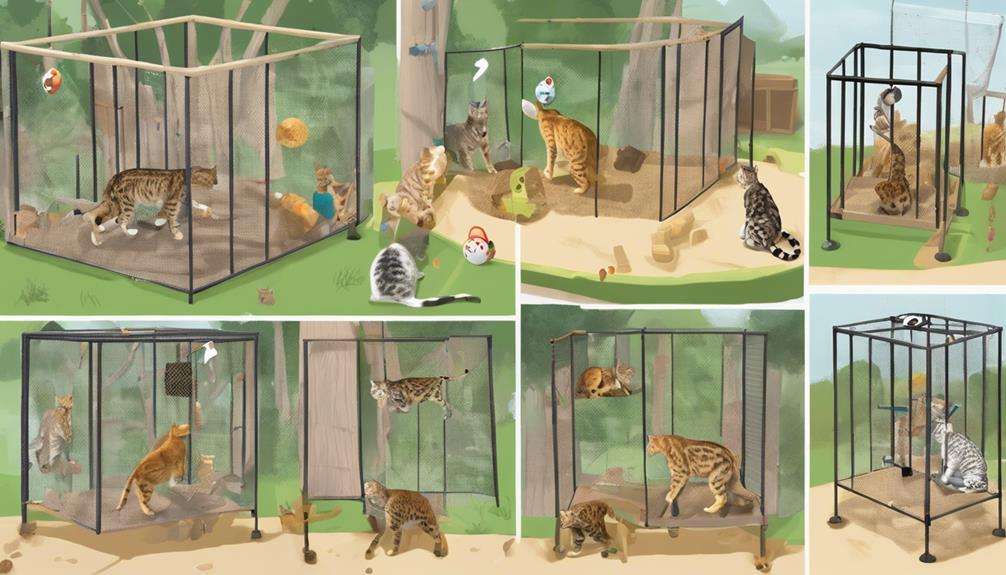
To ensure the well-being of your spotted wildcat companions, it's crucial to focus on training, environmental enrichment, and behavioral modification techniques.
These methods play a vital role in addressing the specific behavioral needs of wild felines like servals and rusty-spotted cats.
Training for Wildcats
Training wildcats, such as servals or rusty-spotted cats, requires a deep understanding of their wild nature and natural instincts to navigate behavioral challenges and provide enriching experiences. When working with these majestic creatures, consider the following:
- Wildcat Training Techniques: Utilize specialized methods that respect their instincts.
- Behavioral Issues Management: Address aggression, stress, and territorial behaviors effectively.
- Enrichment Activities: Provide mental and physical stimulation through toys, climbing structures, and hiding spots.
- Understanding Wildcat Behavior: Gain knowledge about their natural hunting and exploring instincts.
Successfully training spotted wildcats involves patience, expertise, and a profound respect for their wild essence. By incorporating these elements into your approach, you can create a fulfilling and harmonious bond with these incredible felines.
Environmental Enrichment Methods
When enriching the environment for spotted wildcats, it's crucial to understand and replicate their natural hunting behaviors and instincts effectively. Spotted wildcats thrive when their environment provides opportunities to exhibit their innate behaviors.
Behavioral challenges can arise if their natural instincts aren't stimulated, leading to stress and potential behavioral issues. To address this, environmental enrichment methods such as puzzle feeders, climbing structures, hiding spots, and interactive toys are essential. These tools keep spotted wildcats mentally and physically engaged, preventing boredom and frustration.
Proper environmental enrichment is key to preventing stereotypic behaviors and promoting the natural behaviors of spotted wildcats in captivity. By creating a stimulating environment that mirrors their wild habitat, you can enhance the well-being of these majestic felines.
Behavioral Modification Techniques
In successfully addressing behavioral challenges and enhancing enrichment for your spotted wildcats, understanding their natural instincts and needs is paramount. Here are four essential techniques to help you navigate these challenges effectively:
- Recognize Their Solitary Nature: Respect their need for alone time and provide hiding spots for privacy.
- Consider Their Territorial Behavior: Create separate spaces within their enclosure to prevent conflicts.
- Implement Enrichment Activities: Offer interactive toys and puzzles to stimulate their hunting instincts.
- Address Stress-Related Behaviors: Monitor their environment closely and adjust it to reduce potential stressors.
High Level of Activity and Exercise Needs
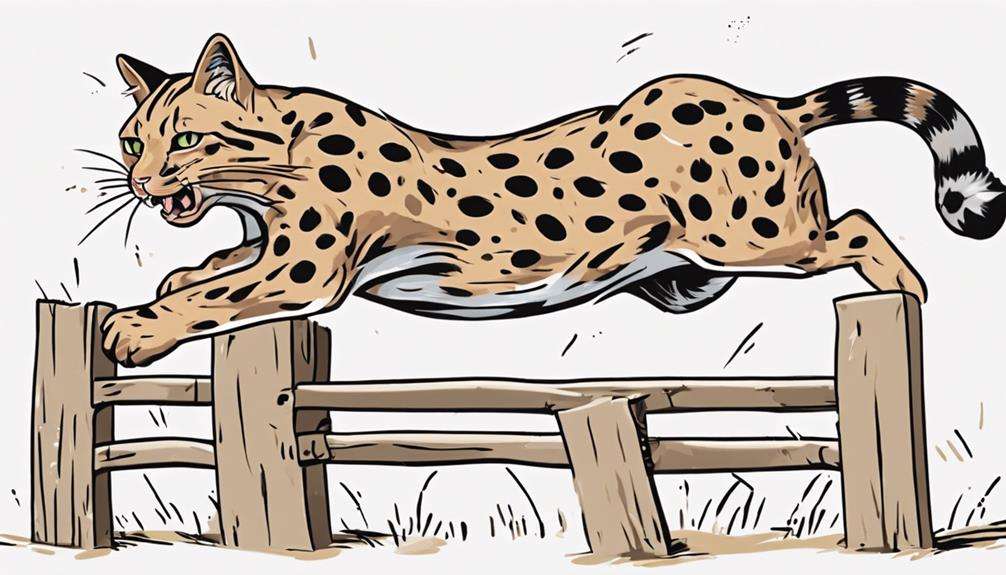
Spotted wildcats, such as servals and rusty-spotted cats, demand a significant amount of space and opportunities for exercise due to their high energy levels. These wild cats have intense exercise needs that must be met to ensure their well-being. Regular physical activity is vital to prevent behavioral issues in these lively felines.
To cater to their high activity requirements, owners must provide engaging toys, climbing structures, and outdoor enclosures. Neglecting the exercise needs of spotted wildcats can result in stress, obesity, and destructive behavior. It's crucial to understand that meeting these needs isn't just about physical health but also about mental stimulation.
Unique Socialization Needs
To ensure the well-being of spotted wildcats, understanding and meeting their unique socialization needs is paramount. These felines, like Rusty-Spotted Cats, are solitary and territorial by nature, requiring large spaces to roam and hunt. Providing adequate enrichment in a domestic setting can be challenging due to their specialized requirements.
Here are four crucial points to consider:
- Solitary Nature: Spotted wildcats thrive best when allowed to be alone, as socializing with other animals or humans can lead to stress and behavioral issues.
- Territorial Behavior: Respect their need for space and territory, as infringing upon it can result in negative behaviors.
- Large Spaces: These cats need ample room to explore and fulfill their hunting instincts, making it essential to provide an environment that mimics their natural habitat.
- Specialized Knowledge: Meeting the socialization needs of spotted wildcats demands expertise and experience to ensure their well-being and happiness.
Potential for Aggressive Behavior
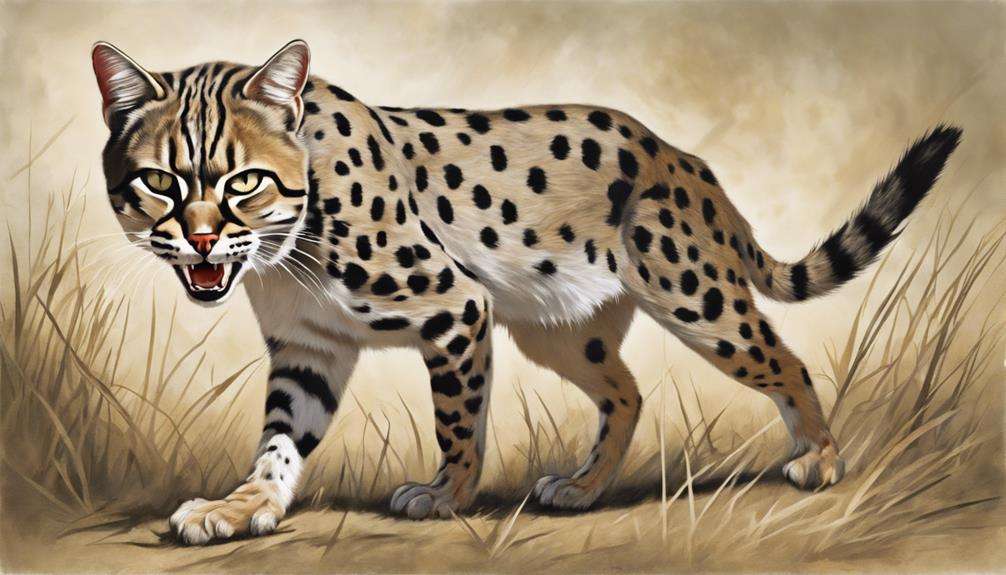
Understanding the triggers for potential aggressive behavior in spotted wildcats is essential for ensuring their well-being and safety in captivity. Spotted wildcats, such as servals and rusty-spotted cats, can exhibit aggressive behaviors when feeling threatened or stressed in captive settings. Aggression in these wildcats can stem from territorial disputes or fear, leading to behaviors like hissing, growling, swatting, or biting.
By being attuned to wildcat body language cues, such as flattened ears or twitching tails, owners can anticipate and mitigate potential aggressive responses. Providing adequate enrichment, like climbing structures and hiding spots, can also help reduce stress and prevent aggressive incidents.
When interacting with spotted wildcats, it's crucial to handle them with care and respect their natural instincts. Properly managing their environment and minimizing potential stressors can go a long way in preventing aggressive behaviors. By fostering a safe and enriching space for these wildcats, owners can help promote their well-being and manage any potential aggressive tendencies effectively.
Financial Considerations and Expenses
When considering the financial aspect of owning spotted wildcats, it's essential to carefully budget for high initial costs and ongoing expenses to ensure the proper care and well-being of these magnificent animals. Here are some important financial considerations to keep in mind:
- Ownership Costs: Owning spotted wildcats can come with hefty initial expenses for enclosures, veterinary care, and specialized diets.
- Regular Expenses: Budget for quality meat, vitamins, and enrichment items to meet their dietary and behavioral needs on a consistent basis.
- Emergency Medical Care: Be prepared for potential health issues that may require costly veterinary treatments, adding to your ongoing expenses.
- Compliance with Wildlife Regulations: Unexpected expenses may arise due to legal requirements, permits, and ensuring compliance with wildlife regulations.
Proper financial planning is crucial when taking on the responsibility of caring for these beautiful creatures. Make sure you're prepared for the long-term commitments and financial responsibilities that come with owning spotted wildcats.
Frequently Asked Questions
Do Spotted Genets Make Good Pets?
Genets don't make good pets due to their wild behavior, specific care needs, and legality issues. Training and socializing them can be challenging. Providing enrichment for genets is crucial for their well-being, but it's best to admire them from afar.
Can I Keep a Rusty-Spotted Cat as a Pet?
You can't keep a Rusty-Spotted Cat as a pet due to legal restrictions, behavioral challenges, and specialized care needs. They are exotic pets that require a wild environment to thrive, best left to conservation efforts.
Can You Keep a Wildcat as a Pet?
You can't keep a wildcat as a pet without legal restrictions, facing behavioral challenges, meeting specific enclosure requirements, and intensive training needs. It's crucial to prioritize the well-being of these majestic animals and admire them responsibly.
What Are the Threats to the Wild Cat?
Habitat destruction threatens wild cats' survival, exacerbating by poaching, human-wildlife conflict, and climate change impacts. These challenges endanger their existence. Protecting their habitats, combating illegal trade, and fostering coexistence are crucial for wild cat conservation.
Conclusion
In conclusion, owning spotted wildcats like the Rusty-Spotted Cat comes with a multitude of challenges that can't be understated.
For example, consider the case of a well-meaning individual who attempted to keep a Rusty-Spotted Cat as a pet without understanding its complex needs. Despite their best efforts, the cat became stressed and unhealthy due to the lack of proper care and environment.
It's essential to prioritize the well-being and conservation of these majestic creatures by supporting them in their natural habitats.
